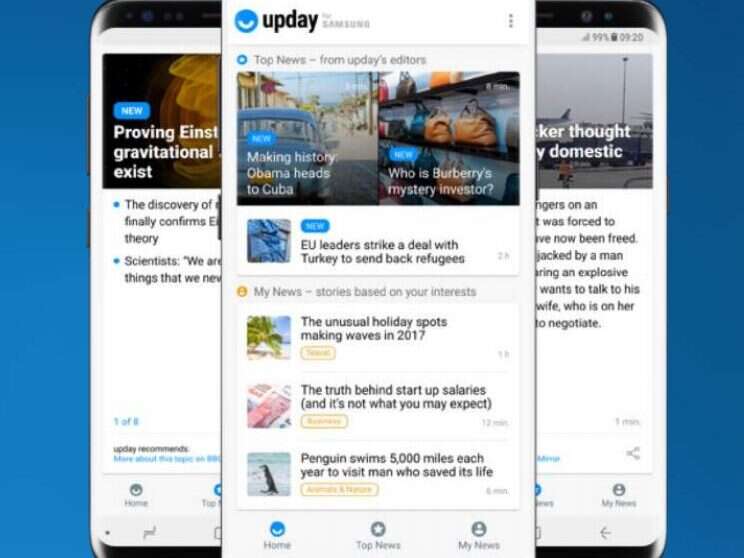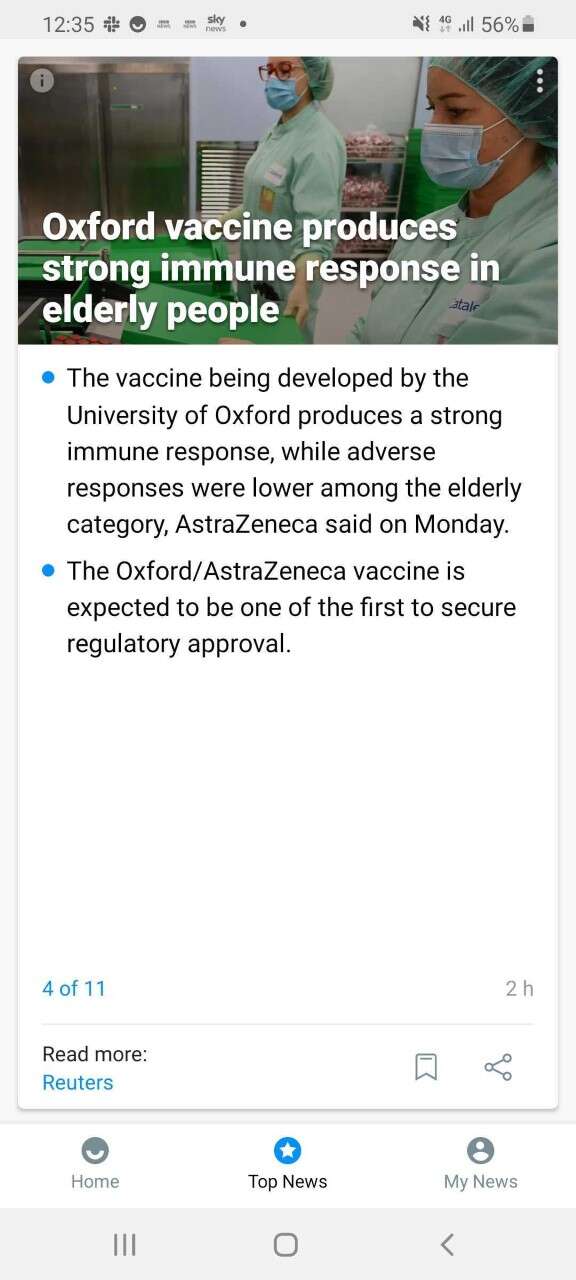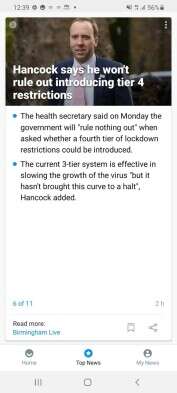
With more than 25m monthly users, Samsung’s preloaded smartphone newsfeed Upday claims to be the most popular news app in Europe. But what is in it for the publishers who provide its aggregated content feed?
While Apple News is currently only available in the UK, Upday is across Europe and particularly strong in Germany. In the second quarter of 2020, Samsung sold 18m smartphones in Europe giving it a 40% market share versus Apple’s 14%.
Upday was created through a partnership between Samsung and German publishing giant Axel Springer – which owns Bild, Die Welt, Business Insider, Politico.eu and several other titles – launching in 2016.
It employs about 50 journalists across its eight major editorial hubs in London, Berlin (HQ), Paris, Milan, Madrid, Warsaw, Stockholm and Amsterdam. It is available in 34 European countries in total, with 18 Eastern European nations using it under a separate licensing model.
Dina Spector, head of editorial for UK and Ireland at Upday, told Press Gazette: “What makes us unique is how we work with content partners. We are extremely collaborative. We think about both the publisher and the reader as a priority.
“We want to make sure that it’s a win-win situation. For the publishers we want to be driving traffic to them and for us it’s a mixture of audience growth and brand awareness.”
The UK is Upday’s second-largest market by audience, behind Germany. It is not available in the US.
The app already works with the likes of the Guardian, Bloomberg, the FT, Politico, Daily Mail, Huffpost UK and Conde Nast, among others.
Upday doubled its audience in March as Covid-19 took hold in the UK.

Dina Spector. Picture: Upday
The basics
How it works
Upday is divided into two sections:
- Top News – curated daily by teams of professional journalists who choose the stories they think are most important to readers in their respective countries
- My News – a personalised news feed compiled by algorithm and based on user preferences
Top News stories are summarised by editors on “cards” – 11 in total – which when clicked take users through to the original article on the publisher’s website. This part of Upday is “all human curation”, said Spector. Publishers can also pitch stories for the Top News section.
“We try to strike a balance between hard news but also subjects within a specific category like science, or tech, or culture, or entertainment,” adds Spector.
“We choose stories that are impacting a large audience, that has both national and international significance, and also stories that are interesting.”
My News uses RSS feeds from chosen publishers. Users can select which areas they are interested in and the algorithm will also bring up related content and trending topics.
Show me the money
Upday itself generates most of its revenue through advertising, both direct and programmatic. It also collaborates with Facebook to curate its Covid-19 information centres and climate change centres.
But, there is no sharing of the ad revenue with publishers. “What we offer the publisher is traffic and reaching an audience that may not normally view their brand,” says Spector.
Upday claims it generated more than 430m visits for UK publishers from January to September this year.
Traffic is driven back to websites, rather than hosted on the platform, so publishers can monetise their own content. Upday uses its own native browser for external websites so it can get around ad-blockers
Upday has a “first click-free” agreement with some publishers whose content is behind a paywall, meaning customers can read the article for free.
A prompt to subscribe to read more content gives publishers a chance to convert the user to a paying reader, but as a general rule, Upday said it tries to avoid putting paywalled content in front of its users.
Upday is experimenting with hosting native video content and does operate a revenue-sharing model with the handful of partners it is working with on this, with Euronews and Business Insider understood to be among them.
This is a new feature that is still being rolled out, so is not widely available, but could grow to become a new revenue stream for publishers.
The pros
Upday’s team of editors who curate the Top News section are its main selling point and ensure the platform isn’t governed entirely by algorithms. This helps to avoid the pitfalls of filter bubbles, toxic content and misinformation that plague other news platforms.
Spector says: “The whole point of Top News is that it is manually curated and that ultimately those stories are determined and fact-checked by humans. We use our editorial judgement and expertise.”
Upday prides itself on having a dialogue with publishers who can pitch stories for space in its Top News section.
Push notifications on Samsung smartphones for both breaking and targeted news are the most powerful weapon in Upday’s arsenal. More than 70% of its audience comes to the app through these notifications, which can lead to a “huge bump” in traffic for publishers, said Spector.
“Effectively it’s reaching everyone in the UK with a Samsung phone who has turned on their notifications, so it’s a pretty large audience.”
The average click-through rate on a story is 10%. A single good story can drive about 300,000 clicks.
Getting content on the platform is relatively simple. Upday already shares content from regional news titles in the UK, such as the Manchester Evening News and Birmingham Live, as well as national titles.
“Either they reach out to us, or we reach out to them,” said Spector on signing up new partner publishers. “There’s no formal agreement, so aside from making sure that they’re a reputable, high-quality publisher, there’s a pretty low barrier to entry.
“Generally it starts with a conversation, we assess their content – is it right for our users? How reliable are they? And the next step is we set up a pitch channel on Slack – that’s the way we like to work – and then we take it from there. They start pitching stories, we start responding.”
Upday launched a second product at the end of last year called earliNews, which is essentially a facsimile of its Samsung offering for Apple iOS – it can be downloaded for free in the App Store.
The cons
Upday is only available on Samsung devices and its push notifications can be turned off, which means its most potent tool for driving traffic to publishers can be silenced. At present it has no market reach in the US, serving only key countries within Europe.
As mentioned, there is no revenue-sharing model. Although Axel Springer has said it is keeping an eye on the trend towards paid content, its model for Upday seems unlikely to change any time soon. Paywalled publishers may find their content does not work well on the platform.
Upday works best when you establish and maintain a relationship with its team of editors, which means attributing some resource to developing this.
Verdict
Upday offers yet another channel for publishers to reach a wider audience for their online content. It’s push notifications in particular can provide publishers with a big traffic hit.
It is easy to sign up to for publishers and rather than put their faith in a machine, they can talk with and pitch to professional journalists whose job is to curate the daily news.
But Upday’s failure to share ad revenue, which is generated by users logging in to read other people’s content, is a familiar story for news publishers in the digital age.
As a means of driving traffic, Upday has a role to play for any publisher, particularly those with an ad-based and free-to-read model, but when it comes to revenue sharing, publishers are left empty-handed.
Picture: Upday
Email pged@pressgazette.co.uk to point out mistakes, provide story tips or send in a letter for publication on our "Letters Page" blog



